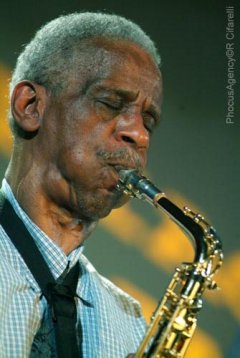Roscoe Mitchell (Art Ensemble Of Chicago)
Roscoe Mitchell is the rare jazz musician who also moves comfortably within the realm of contemporary classical music. It might even be said that Mitchell is a more convincing artist when working in European-influenced forms. Mitchell is a technically superb saxophonist. His tone on alto and soprano tends to be edgy and brittle. At his most lyrical, Mitchell's saxophone lines exploit the instrument's strength as an interval-making machine; his improvised melodies often bear similarity to works by the classical composer Morton Feldman, though Mitchell's music is more overtly emotional. At his most energetic, Mitchell takes advantage of the saxophone's timbral flexibility and the horn's natural tendencies, which allow a player to play fast, scalar lines. Whether playing soft or loud, slow or fast, Mitchell's playing is invariably suffused with passion and intensity.
Mitchell played saxophone and clarinet as a teenager. While stationed in Germany as a member of the Army, Mitchell played in a band with tenor saxophone innovator Albert Ayler. Upon returning to the U.S. in 1961, Mitchell studied with pianist/composer Muhal Richard Abrams. In 1962, he began playing in Abrams' newly organized Experimental Band, a rehearsal group which explored many of the contemporary alternatives to conventional jazz improvisation and composition. In 1965, he became one of the first members of the Association for the Advancement of Creative Musicians (AACM), a non-profit organization established by Abrams, pianist Jodie Christian, drummer Steve McCall, and composer Phil Cohran. The AACM were devoted to the same principles as the Experimental Band. In 1966, Mitchell's sextet became the first AACM group to record. Abstract in concept and execution, the album, Sound (Delmark), was an in-depth examination of the interaction between sound and silence, utilizing such unorthodox devices as spontaneous collective improvisation, toy instruments, and non-musical noise. A departure from the more extroverted work of the New York-based free jazz players, Sound pointed the way to a new manner of playing jazz-based music. Around this time, Mitchell also performed and recorded as a solo saxophonist. By 1969, the Roscoe Mitchell Art Ensemble was touring to Europe. The sojourn was very successful. The band; renamed the Art Ensemble of Chicago; recorded extensively, particularly in France. The resulting albums formed the initial basis of their reputation. The '70s found Mitchell expanding on his solo saxophone concept, working with his AACM cohorts in various combinations and performing with the Art Ensemble. The group became possibly the most highly acclaimed jazz band of the next two decades, winning critics' polls with regularity.
As an improvising composer, Mitchell's use of unusual sonorities and his embrace of quiet sounds helped define an entire jazz subgenre.
